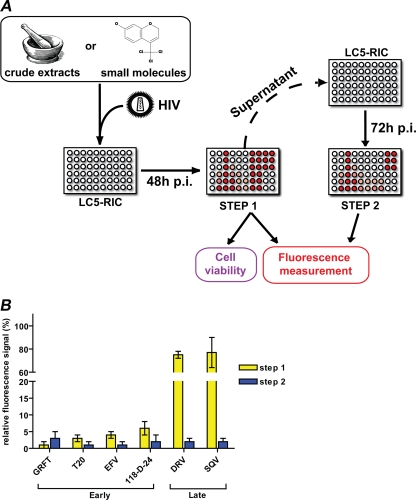FIG. 2.
EASY-HIT standard assay for the identification of HIV inhibitors. (A) Schematic of the EASY-HIT assay. HIV indicator cells LC5-RIC are exposed to test substances (e.g., extracts or single compounds) and virus for 48 h, and inhibitory effects of compounds on HIV replication in these test cultures were evaluated in two steps. The first step measures fluorescence signal intensities of the cells in the test cultures. For the second step, aliquots of supernatants of the test cultures are transferred to a new plate with LC5-RIC cells, and fluorescent signals are measured 72 h after transfer. Effects of test substances on the viability of cells in test cultures are analyzed by MTT assay. (B) Effects of reference compounds known to interfere with the early and late phases of HIV replication on fluorescent signal intensities measured in the first and second steps of the EASY-HIT assay. Fluorescent signal intensities measured for test cultures were normalized to fluorescent signal intensities in control cultures (exposed to HIV only). Inhibitors were used at concentrations corresponding to 3× EC50. All inhibitors reduced the fluorescent signals in the second step of the assay. Early-phase inhibitors reduced the fluorescent signals in the first and second steps of the EASY-HIT assay to <10% of the signal of the infected, untreated control. Late-phase inhibitors reduced fluorescent signal intensities predominantly in the second step and showed only small effects in the first step. Mean values of three wells ± standard deviations are indicated.

